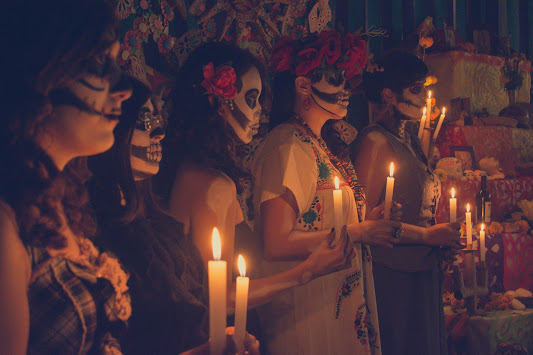Día de los Muertos - Day of the Dead
Today offerings are left on loved one's graves or on makeshift altars at home known as ofrendas. The altars are covered in candles and bright marigolds called cempasuchil to help illuminate the path for the dead to find their Earthly homes. This tradition stems from medieval Spain, where the graves were also decorated with flowers and candles. Conquistadores brought these traditions to the New World in the 16th century.
As far as why marigolds were chosen to represent el Día de los Muertos, it's origin is surrounded by legend. Mexican Marigolds are native to the Americas. The legend of the cempasuchil begins with two Aztec lovers who offered flowers to the Sun god. After one of the lovers was killed, the other begged the god to reunite her with her love. The god cast a ray of sun upon the woman and turned into a flower bursting with fiery colors. Her love was reborn as a hummingbird who found the flower. Their love triumphed over death and became symbolic for el Día de los Muertos.
Other Symbolism
The most well-known representation of el Día de los Muertos are calacas (skeletons) and calaveras (skulls). These symbols are generally seen on candied sweets, parade masks, and dolls. The Calacas and calaveras are mostly portrayed as enjoying life and wearing fancy clothes. José Guadalupe Posada, a cartoonist from the early 20th century, intended to mock Mexicans with his cartoon La Calavera Catrina, or Elegant Skull. It featured a female skeleton adorned with make-up and decorated with fancy clothes. Posada's statement was about how Mexicans adopted European fashions over their own heritage and traditions. La Calavera Catrina is now the most recognizable element of the holiday. Observers of el Día de los Muertos, paint their faces to look like skulls to honor the deceased, and decorate them to represent a lost loved one.
Disney Pixar Animation Studio released the film Coco in 2017. The film follows the story of a boy who is transported into the Land of the Dead where he reconnects with deceased family members and finally realizes why his family celebrates Día de los Muertos. It is a creative depiction that brings to life certain aspects of the holiday and educates a little of the traditions.
Día de los Muertos vs Halloween
While Día de los Muertos and Halloween share some similar traditions like costumes, parades, and time of year, these are two separate holidays. Celebrating a person's life after they die keeps their memory alive and a part of the family who remembers them. Celebrations take many forms, including large parades. Link below for a virtual river parade of el Día de los Muertos.
Día de los Muertos is not just a holiday, but a sacred event for those who believe in it. So pop some corn and put on Coco. You can wish someone a happy Day of the Dead by saying, “Feliz día de los Muertos.”
If there is anything I misunderstood or misrepresented about this holiday, please let me know and I will do my best to correct any mistakes.
You can find links to my resources below:
https://www.history.com/topics/halloween/day-of-the-dead
https://www.nationalgeographic.org/media/dia-de-los-muertos
https://www.inside-mexico.com/the-legend-of-the-cempasuchil-flower/





Comments
Post a Comment